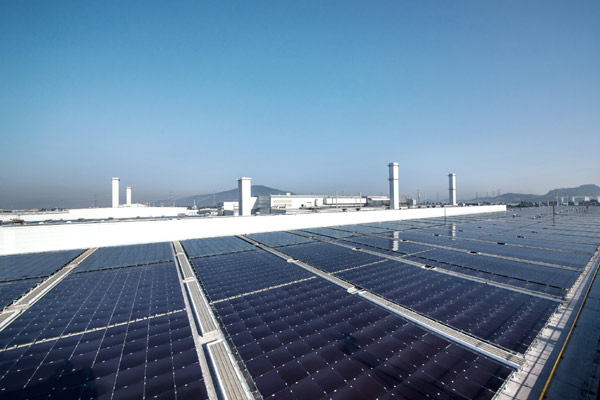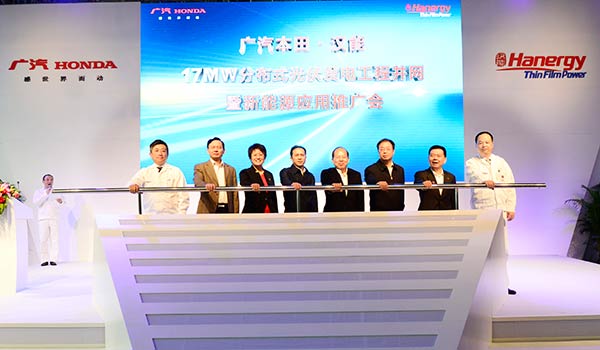 |
|
The thin-film panels in the plant of Guangqi Honda Automobile Co is pictured in Guangzhou, capital of Guangdong province. [Photo provided to chinadaily.com.cn] |
Solar power is becoming a more and more popular energy source for car production sites, as the clean energy reduces carbon dioxide emissions, lowers thermal power consumption and cuts electricity bills.
Beijing-based Hanergy Holding Group provided the photovoltaic technology and thin-film panels to Guangqi Honda Automobile Co's plant in Zengcheng, Guangdong province, and the project was connected to the State Grid Corp of China last month to supply electricity to the grid during non-production hours.
The photovoltaic films on the 240,000-square-meter roof generate 19 million kilowatt-hours of power annually.
The output fulfills 20 percent of the plant's electricity demand and results in 17,500 tons less in carbon dioxide emissions, according to Guangqi Honda, the joint venture between Chinese carmaker GAC Group and Japanese carmaker Honda Automobile.
Guangqi Honda executive deputy general manager Yu Jun said the company's 17-megawatt project was the largest of its kind in China and followed the nation's call for emissions reduction.
FAW-Volkswagen Automotive Co started using a thin-film photovoltaic scheme in its Foshan plant, in Gaungdong province, in 2013. It has a capacity of 10 megawatts and generates 10 million kWh of electricity.
The scheme provides 9.4 percent of the plant's power consumption and reduces pollutant gas emissions by 20,000 tons. Local media reported that FAW-VW's Foshan plant has another project planned with a capacity of at least 40 million watts.
Lin Boqiang, director of the China Center for Energy Economics Research at Xiamen University, said the carmakers' practices were in line with the country's promotional policies.
"China is supporting photovoltaic distributed power generation. These projects may be qualified for government subsidies and will benefit from the smaller expense in electricity. The State Grid also deduct their bills, as the plants are feeding power to the grid when they are off work," said Lin.
Distributed power generation refers to grid-connected small devices that generate electricity.
Beijing-based Hanergy Holding Group also provided the photovoltaic technology and thin-film panels used FAW-VW plants.
A news release from the solar group said that the plants would use less energy for air conditioning when the roofs were covered by photovoltaic panels as they make room temperatures drop by three degrees.
Dongfeng Honda Automobile began using solar power in 2012 in its two plants in Wuhan, the capital of Hubei province.
Volvo Car Corp's Solar Pavilion, displayed at the Guangzhou Auto Show in 2014, is a convertible charging station for one electric car. The three-meter high tent-like device covers a 36-sq-m area and can be installed and dismounted in hours.
On Feb 2, Hanergy's Hong Kong-listed arm Hanergy Solar Group announced that it worked with five vehicle design companies to launch three to five completely solar-powered car models in October.
Hanergy's chairman and CEO Li Hejun topped the Hurun Rich List 2015 with 160 billion yuan ($26.1 billion) in assets.
 |
|
Guangqi Honda Automobile Co's management team and guests started the ceremony of connecting the photovoltaic project to the power grid in Gaungzhou, capital of Guangdong province on Jan 29, 2014. [Photo provided to chinadaily.com.cn] |
